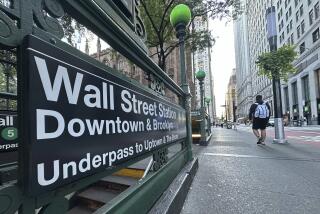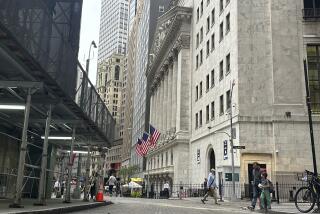COOLING ECONOMY, HOT MARKET : Stocks : Market Hits New Post-Crash High; Dow Soars 49.7
The stock market surged to a new post-crash high Friday, led by a rally in bond prices as government figures fueled expectations of a cooling economy and lower interest rates.
The Dow Jones average of 30 industrial stocks jumped 49.70 points to close at 2,531.87, the highest level since the October, 1987, market crash and surpassing the previous post-crash high of 2,517.83 June 2.
Volume on the floor of the New York Stock Exchange came to 198.72 million shares, up from 176.51 million in the previous session.
The increase--the largest in six weeks--coincided with a rally in bond prices. The price of 30-year Treasury bonds closed up $15 for each $1,000 in face value, with a yield of about 8.2%.
Hope for ‘Soft Landing’
The strong activity followed surprising news of a sharp decline in orders for durable goods such as cars and machinery, which economists regard as a key indicator of the economy’s health. The Commerce Department reported Friday that durable goods orders fell 4.2% in May to $124 billion, indicating that the economy was slowing more than expected, analysts said.
Expectations of the much hoped for “soft landing” of the economy were bolstered by the release of data on personal income and consumption, both of which rose only modestly in May. Economists interpreted the figures as suggesting that the consumerism that has driven the economy may be slowing, analysts said.
Personal income rose only 0.3% in May to a seasonally adjusted rate of $4.39 trillion, the department said. Consumer spending rose only 0.3% in May to an adjusted rate of $3.44 trillion.
The figures added to expectations that the Federal Reserve Board might loosen its hold on the money supply and relax efforts to boost interest rates, perhaps at the July meeting of the Federal Open Market Committee, which sets short-term monetary policy, analysts said.
“In another setting, the durable goods orders may have been interpreted negatively, as heading (the economy) to recession. But clearly what the market wants is a cooler economy, which will permit the Fed to be less restrictive,” said Al Frank, editor of the Prudent Speculator newsletter in Santa Monica.
Such expectations helped keep bond prices strong on Friday, analysts said.
“Investors have said, ‘Ah ha, we now believe that the economy is cooling off, and that bodes well for interest rates,’ ” said Donna Hostetler, research director at Crowell, Weedon & Co. in Los Angeles.
“I think the stock market basically followed the bond market higher,” added Norman E. Mains, director of research and chief economist at Bateman Eichler, Hill Richards in Los Angeles.
Few Expect Drop-Off
Friday’s strong showing on Wall Street may have been amplified by the normal end-of-quarter “window dressing,” in which fund managers trade stocks to dress up portfolios for clients or shareholders, analysts said.
Eventually, euphoria over lower interest rates may give way to fears of lower corporate earnings, leading to a market correction, analysts said.
But for the short term, few expected the market to drop significantly.
“I would expect this move to carry on through Monday, but there may be some profit taking also late on Monday,” said Geraldine Weiss, editor and publisher, of the newsletter Investment Quality Trends in La Jolla. “The momentum is very good . . . (though) as we move higher, the risks become greater.”
Some economists saw the market reaching new highs of between 2,800 to 3,000 before falling again.
“I think our next worry point will be after this month,” Hostetler said. “We’re looking at a trading range of between 2,400 and 2,550 for a while, then we think the next move will be up . . . the market needs a little rest.”
More to Read
Inside the business of entertainment
The Wide Shot brings you news, analysis and insights on everything from streaming wars to production — and what it all means for the future.
You may occasionally receive promotional content from the Los Angeles Times.








